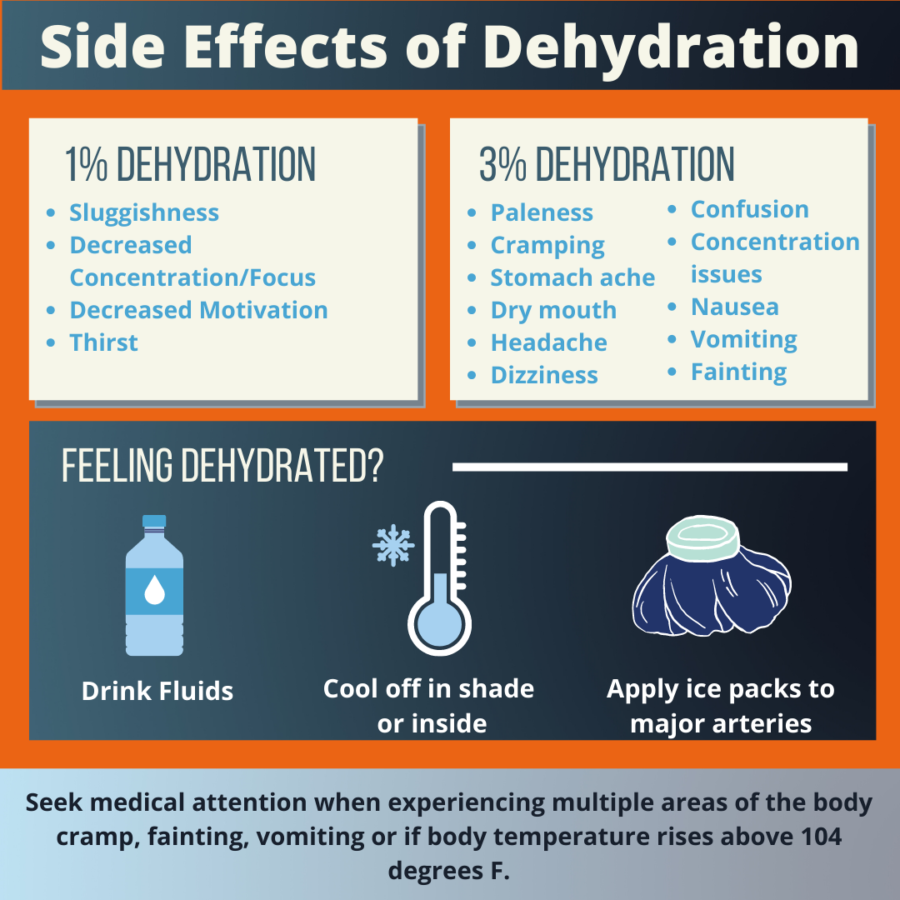Athletes, coaches share how to keep safe while exercising in heat
For more information, visit the Centers For Disease Control and Prevention (CDC).
May 31, 2022
Hotter weather causes school coaches and their teams to be mindful of their practice habits in order to stay safe and healthy. Most sports teams see regular practices over the summer, experiencing Virginia heat at its worst.
“When we’re practicing on the turf, it feels hotter than it actually is on the forecast, so it makes it even harder to stay cool and it makes us tired easily,” varsity boys soccer player and sophomore Mason Phan said. “[With] the practices in the hot weather, the whole team is just not as energetic and we can’t put as much intensity into our practices compared to when the weather’s a little bit nicer.”
Coaches consider the forecast when planning practices. The skills practiced, frequency of water breaks and sometimes the amount of gear athletes wear all depend on the temperature and humidity.
“When it’s not super hot and humid, I can run a practice pretty much any way I want,” varsity girls soccer coach Melissa Bibbee said. “I can include a warm up, some fitness, some technical [and] some tactical [drills]. But if it’s super hot, then I have to take that into mind and not do extra fitness.”
Phan wears brightly-colored clothing which helps to keep him cool by reflecting sunlight, rather than absorbing it.
According to sports medicine teacher Kevin Boss, an athlete’s preparations for exercise in the heat should begin as early as 24 hours prior. Drinking lots of water to stay hydrated and eating a meal containing sugar and protein will set an athlete up for a successful practice or game. The Centers for Disease Control and Prevention (CDC) recommends athletes arrive to work out well-hydrated and drink water post-practice to rehydrate.
“It affects so many other body systems as far as how hydrated you are,” Boss said. “What I try to tell my students and get [them] to understand is that just as little as [a] 1% decrease in body weight in terms of water weight can negatively affect somebody’s performance cognitively. At 3% dehydration they can be physiologically affected, start cramping, having nausea, vomiting [or] fainting.”
It is not uncommon for athletes to experience dehydration at practice. Coaches like Bibbee look out for changes in personality or work rate, sluggishness and perspiration.
“It’s not very pleasant at all actually,” Phan said. “[When] you feel sluggish and dehydrated, you’re more prone to get injured too.”
The CDC advises that athletes should drink one cup (eight ounces) of water every 15-20 minutes, but more than 48 ounces per hour can cause a medical emergency. Normally, Bibbee plans for two to three water breaks in her 90 minute practices. When the temperature is high, she plans for breaks every 20 minutes.
Boss advises that athletes cool down with a stretch and something to drink and eat to replenish nutrients and water that was lost during the work out. According to Boss, there is a 45-minute post-exercise window of opportunity for athletes to replenish nutrients and water. According to Boss, many athletes opt for chocolate milk or a protein shake for their taste as well as high protein and sugar content.
“They have to recognize how they feel when they’re at that 1% threshold, when they’re at that 3% threshold,” Boss said. “So you can get an understanding of when you’re in the danger zone and when you’re not, hydrate the day before and make sure [you] know [your] body. Gradually grow your exercises into the heat before you try [to] do maximal output.”






